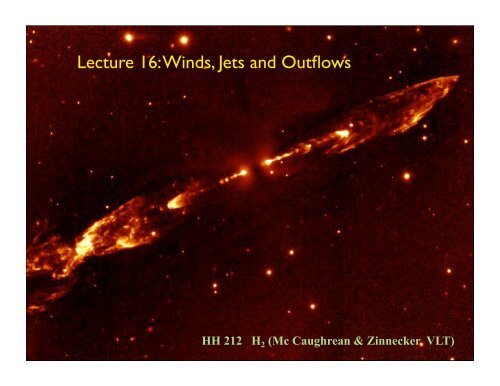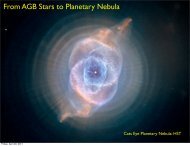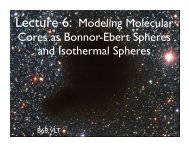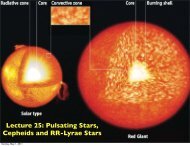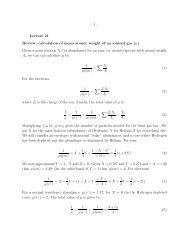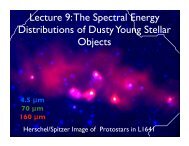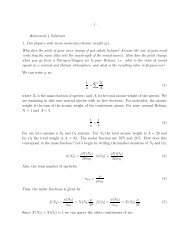Lecture 16: Winds, Jets and Outflows
Lecture 16: Winds, Jets and Outflows
Lecture 16: Winds, Jets and Outflows
- No tags were found...
You also want an ePaper? Increase the reach of your titles
YUMPU automatically turns print PDFs into web optimized ePapers that Google loves.
<strong>Lecture</strong> <strong>16</strong>: <strong>Winds</strong>, <strong>Jets</strong> <strong>and</strong> <strong>Outflows</strong>HH 212 H 2 (Mc Caughrean & Zinnecker VLT)
Losing Material from the Outer DiskThrough Photoevaporation
Formation & viscous spreading of disk
Formation & viscous spreading of disk
Formation & viscous spreading of disk
Photoevaporation of disks(Very brief)Ionization of disk surface creates surface layer of hot gas. Ifthis temperature exceeds escape velocity, then surfacelayer evaporates.v esc≈ GM 1/ 2⎛⎛ ⎞⎞⎜⎜ ⎟⎟⎝⎝ r ⎠⎠Evaporation proceeds for radii beyond:€r ≥ GM ≡ r2 grc sHII
The Edge of The Solar System:Evaporation of Disks by UV RadiationCenter of OrionNebulaHot O <strong>and</strong> B-typestars producepowerful UVradiation field.Young disk bathed inUV light.
Why is there an Edge to the Solar System:Evaporation of Disks by UV Radiation
Losing Material from the Inner Disk:through Accretion <strong>and</strong> Outflow9
Magnetospheric accretionFree-fall <strong>and</strong> accretion shockFrom r A down to star: matteris in supersonic free-fall.Accretion shockFree-fallregionNear the star the matter getsto a halt in a st<strong>and</strong>-off shock.r iShock velocity:v s=2GM 1− r *r *r iDissipated energy (=accretion luminosity from shock):⎛⎛L€accr= 1− r ⎞⎞*⎜⎜ ⎟⎟ G M ˙ M⎝⎝ ⎠⎠r ir *
Bipolar outflows<strong>Jets</strong> originatefrom innerregions ofprotoplanetarydisksHubble Space Telescope image
Magnetically threaded disksSuppose disk is treaded by magnetic field:Inward motion of gas in disk drags field inward:B-field aquiresangle with disk
€Disk windsSlingshot effect. Bl<strong>and</strong>ford & Payne (1982)(courtesy:C. Fendt)Use cylindricalcoordinates r,zGravitational potential:Φ = −GMr 2 + z 2Effective gravitationalpotential along field line (incl.sling-shot effect): €Φ = − GM ⎡⎡1 ⎛⎛⎢⎢ ⎜⎜r 0 ⎣⎣ ⎢⎢ 2 ⎝⎝rr 0⎞⎞⎟⎟⎠⎠2+r 0r 2 + z 2⎤⎤⎥⎥⎦⎦ ⎥⎥
Disk windsBl<strong>and</strong>ford & Payne (1982)€Φ = − GM ⎡⎡1 ⎛⎛⎢⎢ ⎜⎜r 0 ⎣⎣ ⎢⎢ 2 ⎝⎝rr 0⎞⎞⎟⎟⎠⎠2+r 0r 2 + z 2Critical angle: 60 degreeswith disk plane. Beyondthat: outflow of matter.⎤⎤⎥⎥⎦⎦ ⎥⎥InfallOutflowGas will bend field lines
Disk + star: X-wind model of Frank ShuShu 1994
Different kinds of <strong>Winds</strong>Ferreira, Dougados, Cabrit 2006Bl<strong>and</strong>ford & Payne 1982Konigl & Pudritz 2000Shu et al. 1994Matt & Pudritz 2005,…Configuration favorable for outflowsPirated from talk byMarina RomanovaBunching, α v > α d18
Magnetocentrifugal <strong>Winds</strong>Romanova et al. 2005; Ustyugova et al. 2006; Romanova et al. 2009
<strong>Jets</strong> or <strong>Winds</strong>?
Wind Blown Cavities
Bipolar <strong>Outflows</strong> driven by WindShu et al. 1991
Equations for core:Wind Blown BubbleEquations for wind:
Wind Blown Bubble
Wind Blown Bubble
Creating <strong>Jets</strong>
Creating <strong>Jets</strong>: Magnetic field winding - confinementC. Fendt
€Magnetic field winding - confinement(courtesy:C. Fendt)€j = c4π ∇ × Bf = 1 cj × BRight-h<strong>and</strong> rule:force pointsinwards
Hydrodynamic confinement in jet:Shock only reduces the velocity component perpendicularto shock front. Therefore obliquely shocked gas isdeflected toward the shock plane.
Hydrodynamic confinement in jet:
Bipolar outflows driven by <strong>Jets</strong>Swept-up material(molecular outflow)Terminal shockHydrodynamicconfinement?Hot bubble of old jet materialMagnetic confinementMagneto-centrifugallaunching (
Head of the jet:Turbulent mixing between old jetmaterial <strong>and</strong> swept-up environment(entrainment)St<strong>and</strong>-off shock (most of jetenergy dissipated here)Contact discontinuity(boundary between jet<strong>and</strong> external medium)Back flowBow shockShocked external medium gas(molecular outflow)Jet flow much faster than propagation of bow shock.Jet material much more tenuous than external medium
Most Likely a Combination of Both
The Propeller RegimeDisk radius > Corotation Axis:Magnetic field rotating faster than diskUstyugova et al. 2006
<strong>Outflows</strong> at the Propeller Stage:Conical <strong>Winds</strong> + Axial JetA star spins-down due to axial magnetic jetPirated from talk by Marina Romanova23
Observed knot movement
Observations of <strong>Jets</strong> <strong>and</strong> <strong>Winds</strong>
Herbig-Haro ObjectsDiscovered independently by George Herbig <strong>and</strong> Guillermo Haroin 1950sSmall knots of nebulosity in dark cloudsDisplayed lines of hydrogen <strong>and</strong> forbidden lines of [OI], [NII] <strong>and</strong>[SII].Now known to be shock ionized nebulae.More than 400 Herbig Haro (HH) objects are known.Only trace a small fraction of the outflowing gas
Reipurth et al1989Forbidden Lines, Atomic HydrogenLines <strong>and</strong> Molecular Hydrogen LinesReipurth et al1989Carratti o Garatti et al. 2008
HH 111Knots are probably internal shocks, where faster knots are crashing intoslower knots[Fe II] + KHa + [SII]NICMOSWFPC2
HH 212 H 2 (Mc Caughrean & Zinnecker VLT)
HH 46/47 NTT [OΙΙ] Ηα [SΙΙ] = 0.38, 0.65, 0.67 µmBally & Reipurth (06 “Birth of Stars & Planets” CUP = BR06)
HH 46/47 Spitzer H 2 PAH 3.6, 4.5, 8 µm(Noriega-Crespo 04; BR06)
HST 1994HH 46/47(Hartigan et al. 05, AJBR06)
HST 1997HH 46/47(Hartigan et al. 05, AJBR06)
HH 2 HH 1HST 1997 - 1994
HH 2 HH 1HST 1997 - 1994
HH 1 jetHST 1997 - 1994
HH 1 jetHST 1997 - 1994
HH 1HST 1997 - 1994
HH 1HST 1997 - 1994
HH 2HST 1997 - 1994
HH 2HST 1997 - 1994
HH 34HST 1997 - 1994
HH 34HST 1997 - 1994
Molecular <strong>Outflows</strong>
Molecular<strong>Outflows</strong>:Line WingsBally & Lada1983
Molecular<strong>Outflows</strong>:BipolarityBally & Lada1983
Molecular <strong>Outflows</strong>: Basic PropertiesBally & Lada 1983
Molecular <strong>Outflows</strong>: Mechanical Luminosity<strong>and</strong> Momentum FluxBally & Lada 1983
MolecularOutflow: the“Hubble Law”NGC 2264 GFich & Lada1998
DistinguishingBow shockbetweenWind <strong>and</strong> JetModelsLee et al. 2001Wind
HH 288:Contours: CO(2-1)Greyscale: H 2
HH 211Contours: CO(2-1)
VLA 05487: example of wind (Lee et al. 2001)
DistinguishingBow shockbetweenWind <strong>and</strong> JetModelsLee et al. 2001Wind
HH 212: example of jet (Lee et al. 2001)
Detecting <strong>Jets</strong> in Molecular GasHH 211 jet
Detecting <strong>Jets</strong> in Molecular GasSiO mm-wave rotational lines are an excellent tracer of jets:abundance enhanced by a few orders of magnitude in jets
HH 211 Lee et al. 2007
SiO HH 212 Codella et al. 2008
HH212Lee etal.2007
HH 212 Lee et al. 2007


